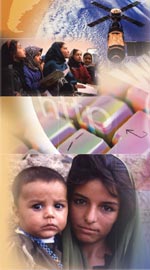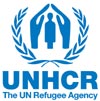| Home : ITU News magazine | |||||||
Due to the particular hardship Afghanistan is facing, the communication and development needs are initially best achieved through shared access. This can be done through the construction of telecentres, which will provide community access to information and communication technologies (ICT). Telecentres bring the Internet, telephone and fax access to people who would otherwise remain deprived of these facilities. An International Day of Charity — Golf was launched on the occasion of this year’s World Telecommunication Day (17 May), under the slogan “Passion makes possible”, to raise funds to implement one or several telecentres. Under the terms of the project document signed by ITU, UNHCR and IGA-FS, this fund-raising campaign that will continue throughout the year, seeks to encourage golfers to support a concrete humanitarian action aimed at helping people in a country in need through a donation of a minimum of USD 100. The campaign is not limited to golfers alone, but is open to any individual wishing to support the project. Each donor will receive a participation certificate. All those working for this grassroots charity movement are volunteering their time and effort with the sole satisfaction of making a lasting difference in the lives of people who need a helping hand. Both ITU and UNHCR have institutional programmes to assist Afghanistan. An ITU resolution adopted at the World Telecommunication Development Conference in Istanbul (Turkey) in March 2002 recognizes that Afghanistan “at present does not have a national telecommunication infrastructure”. Neither does it have access to international telecommunication networks or to the Internet. The resolution states that “under the present conditions, and in the foreseeable future, Afghanistan will not be able to rebuild its telecommunication systems without help from the international community, provided bilaterally or through international organizations.” It goes on to recognize that a modern and efficient telecommunication system is an important ingredient in the massive reconstruction and rehabilitation efforts and the relief operations under way in Afghanistan. In this context, the resolution calls on ITU to provide assistance and support to Afghanistan, in rebuilding its telecommunication infrastructure, establishing institutions for the sector, developing telecommunication legislation and regulatory framework, including a numbering plan, spectrum management, tariff and human resources development and all other forms of assistance.
Project description
|
|||||||

“Today, in Afghanistan, a girl will be born. Her mother will hold her and feed her, comfort her and care for her just as any mother would anywhere in the world. In these most basic acts of human nature, humanity knows no divisions. […] Even though her mother will do all in her power to protect and sustain her, there is a one-in-four risk that she will not live to see her fifth birthday. Whether she does is just one test of our common humanity — of our belief in our individual responsibility for our fellow men and women. But it is the only test that matters. […] I speak of a girl in Afghanistan, but I might equally well have mentioned a baby boy or girl in Sierra Leone. No one today is unaware of this divide between the world’s rich and poor. No one today can claim ignorance of the cost that this divide imposes on the poor and dispossessed who are no less deserving of human dignity, fundamental freedoms, security, food and education than any of us. The cost, however, is not borne by them alone. Ultimately, it is borne by all of us — North and South, rich and poor, men and women of all races and religions. Remember this girl and then our larger aims…” Extracts from the Nobel Lecture delivered by the United Nations Secretary-General, Kofi A. Annan, in Oslo on 10 December 2001 (http://www.un.org/News/Press/docs/2001/sgsm8071.doc.htm).ITU 020086/UNHCR/L. Boscardi |
Each telecentre will be provided on a turnkey basis (including building, equipment, infrastructure and initial operating costs). The contribution of the local community will be to take charge of the operation of the telecentre with a view to making it a self-sustainable facility. To this end, the telecentre managerial team will be trained to operate these privately run public facilities themselves.
It is envisaged that revenue derived from fee-paying customers (humanitarian and development organizations, NGOs and media) in the first phase of the project will offset the free access to be offered to low-income users from the local community. Basic telecommunication services (telephone and fax) will be subject to a minimal charge commensurate with the capacity of the users to pay. As revenue-generating activities expand, reliance on cross-subsidization will be reduced. Over time, the telecentre should become self-reliant, based on revenue generated from institutional subscriptions.
Learning from others
In Ginnack, a remote island village on the Gambia River, two nurses use a digital camera to help them keep disease at bay. Whenever they are faced with unfamiliar medical cases, they take pictures of visible signs of illness, download them to a personal computer in a nearby telecentre and e-mail them for examination by a doctor in a distant city. If that physician needs further evaluation of the images, they are sent over the Internet to the United Kingdom where they are then forwarded to specialists from around the world for a diagnosis.
In a small village near Chincheros in Peru, a Peruvian Internet service provider, NGOs and the Peruvian Ministry of Agriculture hooked up the village to the Internet as a pilot project. The local Council took the opportunity of the Internet to establish an online partnership with an international export company to market their produce. In less than two years, the 50 families living in the village went from an annual income of USD 300 a month to some USD 1500 per month after Chincheros’ vegetables began to be sold in the New York market.
Women and telecentres
Women throughout the world engage in formal and informal employment and other entrepreneurial income-generating activities. Cases around the world demonstrate that telecentres have the potential to meet a range of women’s needs. These include training in technology skills, and opportunities to pursue activities that contribute to the individual’s well-being. They also contribute to improving women’s self-confidence, and have an overall positive impact on learning. The benefits are not confined to the women themselves. Their activities contribute to the strengthening of community ties, and building networks among women that support information-sharing and advocacy efforts.

Management of the proposed telecentre in Afghanistan is to be entrusted to a group of women from Kabul. The fact that there are currently very little employment prospects for women is a strong argument to provide them with this opportunity to reassert themselves in society ITU 020088/UNHCR/P. Benatar |
It is therefore envisaged that the management of the telecentre in Afghanistan will be entrusted to a group of women from Kabul. The fact that there are currently very little employment prospects for women is a strong argument to provide them with this opportunity to reassert themselves in society. An opportunity that will help women to support themselves, their families and their community.
The IDC-G website (www.idc-g.org) is administered by the International Golf Associates Franco-Suisse Chapter.


